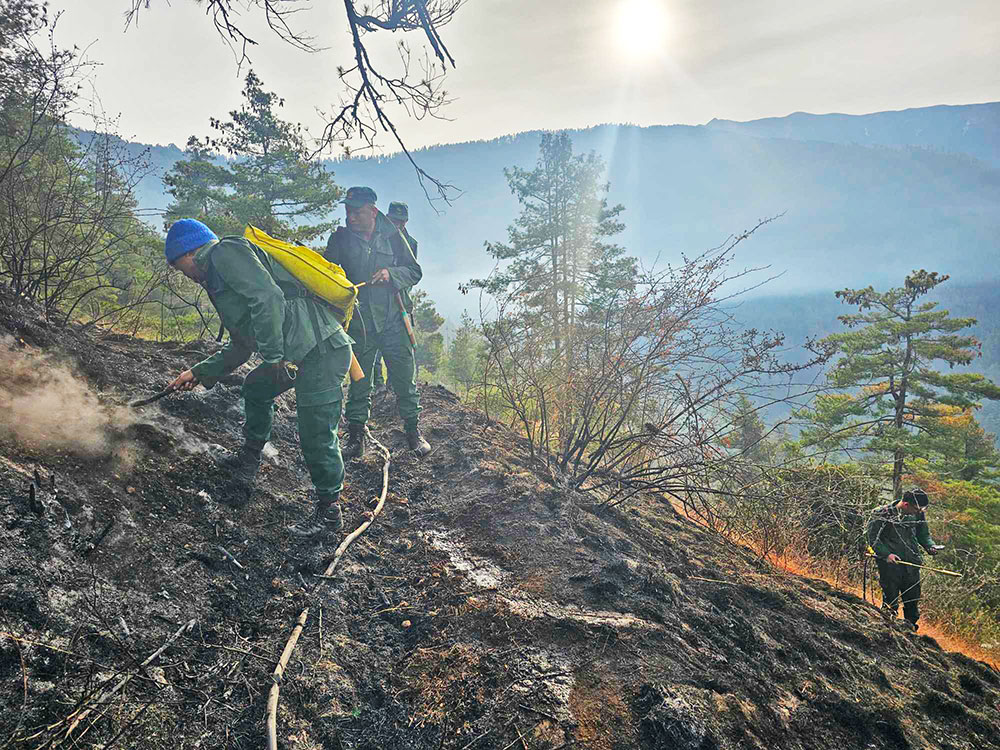KP Sharma
In a remarkable evolution from the archaic methods of battling wildfires, Bhutan’s forestry sector has embraced cutting-edge firefighting technologies, marking a pivotal moment in the nation’s environmental resilience.
The deployment of state-of-the-art fire water backpacks, courtesy of the WWF-Bhutan, is transforming the landscape of forest fire management, providing a more efficient and strategic approach to combating the escalating threat.
Bhutan grapples annually with environmental devastation caused by forest fires, a challenge exacerbated by the mounting frequency of fire incidents. In 2019, 40 fire incidents consumed a staggering 3524.72 hectares, a number that surged to 77 incidents and 8697.34 hectares in 2023. This escalating crisis necessitated a paradigm shift in firefighting capabilities, prompting the WWF-Bhutan’s intervention through the IKI Living Landscape initiative.
The rugged mountainous terrain, coupled with unforgiving winter winds, posed formidable obstacles to conventional firefighting efforts. In response, the Department of Forest and Park Services’s (DoFPS) collaboration with WWF-Bhutan targeted the deficiencies in equipment, a critical bottleneck in effective wildfire control.
The influx of essential firefighting equipment, ranging from blowers and chainsaws to personal protective gear, has revitalised Bhutan’s firefighting capabilities. The DoFPS received a substantial arsenal, including 100 backpack pumps, seven grass cutters, chainsaws, and other essential tools. This windfall is not only a lifeline for current firefighting efforts but a strategic investment for the future, with a focus on the upcoming Gyalsung training program.
A forest officer, Karma Chorten Dendup said that the department has received a variety of firefighting equipment, including blowers, chainsaws, spades, gloves, goggles, grasscutters, and drip torches.
In terms of quantity, the DoFPS received 100 backpack pumps, seven grass cutters, seven leaf blowers, seven chainsaws, seven drip torches, 100 spades, and three suction hoses.
In addition, they received 10 sets of personal protective equipment (PPE) comprising safety pants, jackets, boots, goggles, fire masks, fire gloves, and torches.
Further, the department acquired 10 sets of shovels, rakes, spades, pulaski, and multi-purpose landscaping tools for firefighting purposes.
He said that these procurements are intended for use in the Training of Trainer (ToT) sessions for the Gyalsung training module focused on forest fire management.
The Gyalsung programme is a year-long national service initiative for all Bhutanese youth after completing class 12, is scheduled to commence in September this year.
“Following the completion of this training, the equipment will then be used during the official Gyalsung training, where hands-on training shall be provided during the Gyalsung program on the operation of this equipment,” the officer added.
The Gyalsuups will be trained in the different mechanisms and techniques employed during forest fire suppression, such as backfiring, tactical fires, and prescribed burning, according to the officer.
They will also be trained in forest fire prevention and mitigation measures such as fire line construction and fuel reduction treatment methods. They will also receive training on assisting casualties.
“The curriculum on forest fire management in the Gyalsung program shall help build in the youth the knowledge and the skills required for fire management.”
The concern regarding insufficient firefighting equipment became a topic of discussion even during the government’s meeting with the media.
The former Minister for Energy and Natural Resources, Loknath Sharma, said that firefighting efforts in the country were often hindered by a lack of resources, with only 68 trained firefighters available.
Firefighters frequently attribute their challenges in managing fire incidents to a shortage of proper equipment and insufficient human resources, impeding their effectiveness in combating wildfires.
The WWF contributed Nu 11.4 million for the department to procure the necessary equipment.
According to Karma Chorten Dendup, the firefighting equipment is now distributed uniformly through the IKI Landscape and is effectively used in the field.
The material support from WWF-Bhutan is expected to enhance the capabilities of quick-response teams in the project landscape. These teams are responsible for delivering initial aid responses to manage wildlife intrusions into human settlements.
The forestry and firefighting equipment are also expected to improve the technical and management effectiveness of nine divisional forest offices in southwestern Bhutan.
This is expected to contribute to reducing human-wildlife conflicts within communities residing in the project landscape.
To effectively utilise this equipment, foresters have been trained in using forest fire equipment during their training and over the years combating and fighting forest fires.
Further, he stated that there are plans for imparting additional training on forest fire management in the coming years, which would include effective utilisation of the tools and gears.
Fire is also an important component in the national adaptation plan of Bhutan and DoFPS is currently working on spreading awareness of forest fires, efficiently, mitigating the damage to both natural resources and human assets.
Further, the department has established an early detection system in collaboration with ICIMOD, Nepal.
“In the event of a forest fire, the relevant jurisdiction’s focal officer is promptly notified via email alert, which contains comprehensive information regarding the forest fire.”
This empowers the officer to promptly notify others and respond appropriately to the forest, especially at the onset of fire season.
“We are also working towards enhancing the capacity of the forester and other important stakeholders on forest fire management,” the department added.
Aside from the awareness and campaigns about forest fire to the public on various platforms, the DoFPS has initiated the establishment of the Interagency Forest Fire Coordinating Group (IFFCG) in the thirteen fire-prone dzongkhags in Bhutan from 2017 to 2023.
According to the department, IFFCG is a coalition of multiple agencies such as RBP, RBA, Desuups, Foresters, and Dzongkhag Management tasked with effectively suppressing forest fires and providing swift response in the event of a forest fire.
Further, the department has established an early detection system in collaboration with ICIMOD, Nepal.
“In the event of a forest fire, the relevant jurisdiction’s focal officer is promptly notified via email alert, which contains comprehensive information regarding the forest fire.”
This empowers the officers to promptly notify others and respond appropriately to forest fires.


